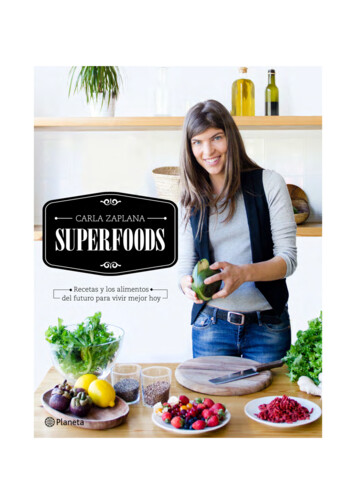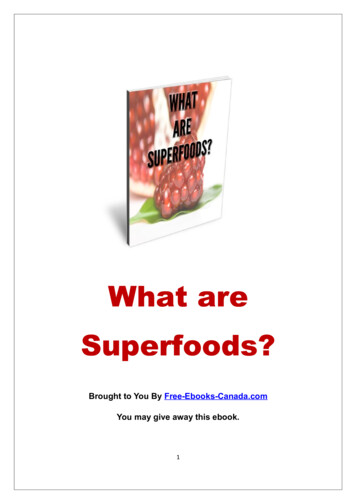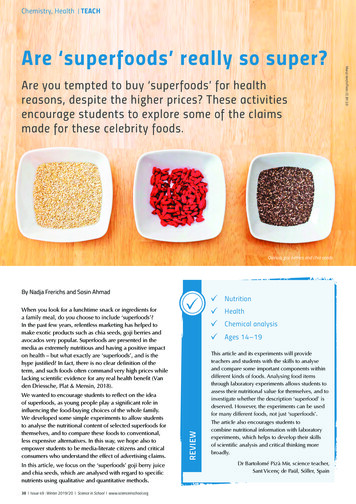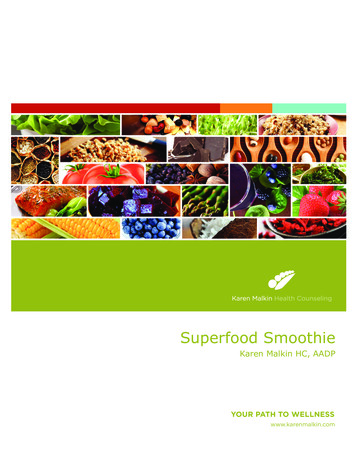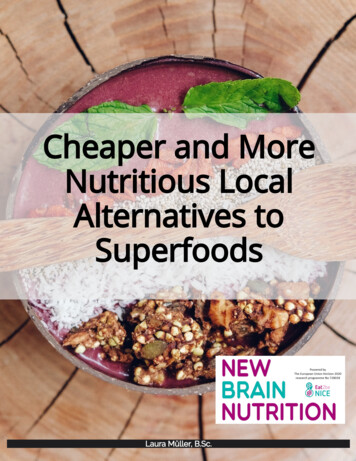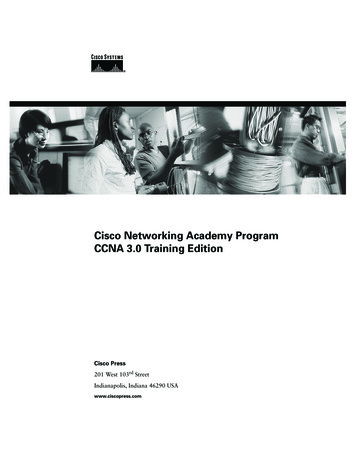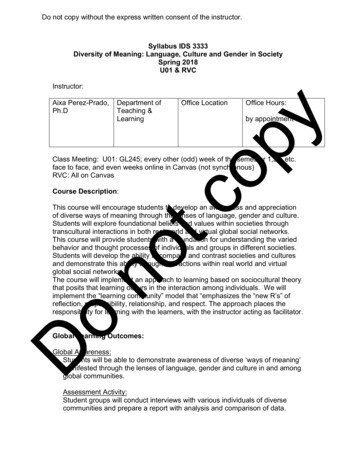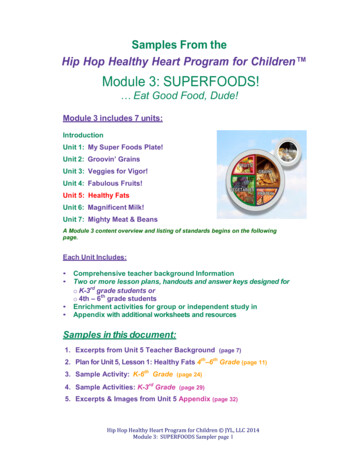
Transcription
Samples From theHip Hop Healthy Heart Program for Children Module 3: SUPERFOODS! Eat Good Food, Dude!Module 3 includes 7 units:IntroductionUnit 1: My Super Foods Plate!Unit 2: Groovin’ GrainsUnit 3: Veggies for Vigor!Unit 4: Fabulous Fruits!Unit 5: Healthy FatsUnit 6: Magnificent Milk!Unit 7: Mighty Meat & BeansA Module 3 content overview and listing of standards begins on the followingpage.Each Unit Includes: Comprehensive teacher background InformationTwo or more lesson plans, handouts and answer keys designed foro K-3rd grade students oro 4th – 6th grade studentsEnrichment activities for group or independent study inAppendix with additional worksheets and resourcesSamples in this document:1. Excerpts from Unit 5 Teacher Background (page 7)2. Plan for Unit 5, Lesson 1: Healthy Fats 4th–6th Grade (page 11)3. Sample Activity: K-6th Grade (page 24)4. Sample Activities: K-3rd Grade (page 29)5. Excerpts & Images from Unit 5 Appendix (page 32)Hip Hop Healthy Heart Program for Children JYL, LLC 2014Module 3: SUPERFOODS Sampler page 1
Module 5 OverviewUnitLearning ObjectivesActivities/Worksheets1. MySuperfoodsPlate Name five food groups that supportheart health Understand what comprises ahealthy meal Explain the relationship betweennutrition and health Explain the value of a balanceddiet Name some nutrition-packed foodsfrom each food group Know what nutritious foods arestored in their homes Explain what a calorie is and howcalories fit with food choices Explain how physical activityinteracts with diet to sustain health SuperFoods! Rhyme Fix Yourself a Plate Find Good Food! Healthy Snacks Are Good to EatRhyme Go for Nutrients Handout Choose Your Healthy Snack What’s in Your Snack Worksheet(s) Get Moving! Food Groups for the Food Bank Super Sleuth Take the Quiz Calories In/Calories Out ChartUnit 2. Groovin’Grains! Describe the common grains usedto make food products. Describe the three parts of a grainkernel. Compare characteristics of wholeand refined grain foods. Describe how grains are grown andprocessed. Compare characteristics andbenefits of whole and refined grainfoods. Discuss how grain portionscontribute to a healthy diet. Explain the role of bread innutrition Differentiate among varieties ofbreads Understand the benefits ofincorporating whole grains Know how bread is made Describe the role of fermentation inbaking breads Practice making one or more typesof bread Groovin’Grains Rhyme Grain kernel Image Where Grains Grow in the U.S.Worksheet & Key Measure the Wheat GrassInstructions & Worksheet Super Sleuth Worksheet & Key Complex Carbs Simple Carbs Serving Sizes Chart – pages 1 & 2 How Many Servings? Worksheet &Key Carbs in Detail Handout Breads Around the World Grains Growing Images for Posting Amounts & Substitutes Cool Facts about Groovin’ Grains Vocabulary TakeHome & Key Unit 2 Assessment Letter to ParentsHip Hop Healthy Heart Program for Children JYL, LLC 2014Module 3: SUPERFOODS Sampler page 2
Unit 3. Veggiesfor Vigor! Discuss the size of the vegetableportion on the My Plate Image Discuss the health benefits ofvegetables Investigate ideal vegetableportions in a healthy diet Investigate how vegetables aregrown and processed. Compare different ways to enjoyvegetables Practice preparing vegetables oneor more waysUnit 4. FabulousFruits! Discuss the size of the fruitportion on the My Plate Image Discuss the health benefits ofeating fruits Investigate ideal fruit portions in ahealthy diet Know how much fruit to integrateinto a healthy diet Describe and comparecharacteristics of various fruitsUnit 5. HealthyFats! Understand the role of certain fatsin a healthy diet. Discuss the purpose and functionsof fat Identify the health benefits andrisks of certain fats and oils Name benefits of including certainfats in a healthy diet Determine appropriate amounts offat to include in a healthy diet Practice using fats in cooking Veggies for Vigor Rhyme Get Moving 2! Veggies Rainbow Taking Measure Daily Dining Daily Dining 2 Eyeball It! Handout A Veggie Valentine! Veggie Mask Activity Parts We Eat Cruisin’ the Salad Bar! Fix Your Salad Plate! Just Steamin’ Unit 3 Vocabulary Unit 3 Quiz Cool and Colorful! Vegetable Information Handout Fabulous Fruits Rhyme Enjoy Fruit Fruit in Color Nutrients Handouts (3) Fruit Search Ripening Record Go for Nutrients Taking Measure Fruitful Choosing Eyeball It! – Fruits Handout Fruitful Tracking Unit 4 Vocabulary Work Unit 4 Quick Quiz Let’s Hear It for Fats! Rhyme Plaque Busters! Fats to Know Handout Searching Oil/Water Mix Eyeball It (fats) Eat Good Fats Cool Facts about Fats Build a Better Peanut ButterSandwich Dancing to Measure Unit 5 Vocabulary Smoke Points Chart Images Take the Quiz!Hip Hop Healthy Heart Program for Children JYL, LLC 2014Module 3: SUPERFOODS Sampler page 3
Unit 6.MagnificentMilk!!Unit 7. MightyMeat and Beans! Discuss the size of the dairyportion on the My Plate Image. Identify nutrients in milk Compare characteristics ofdifferent foods in the milk group Compare liquid and solid milkfoods Discuss the health benefits ofdairy foods Discuss recommended quantity,portion size and type of milkfoods Examine ways to make wisechoices from the dairy group Examine how milk foods are usedin cooking and baking Discuss the size of the proteinportion on the My Plate Image Identify foods in the meat andbeans group Discuss the health benefits ofproteins Identify complete and incompleteprotein foods Determine how much protein foodto eat daily and weekly Compare characteristics of proteinfoods. Discuss the value of varying thetype of protein food eaten. Compare different ways to enjoyvegetables Practice preparing protein foodsone or more ways Magnificent Milk Rhyme A Peek inside a Dairy Cow Handout How Do Cows Make Milk How Much Milk Can One Cow Make Calcium Crossword What Do Dairy Cows Eat? Handout Farm Tour Images Farm to Table Guide Calcium Crossword Milk Serving Sizes Calcium Calculator Handout Taking Measure Bone Up on Calcium Relay Create Your Own Blender Buzzer Build a Better Grilled Cheese International Cheese Activity Guide Marvelous Milk? Vocabulary Quick Questions Assessment Average Milk Consumption Image Relay Station Signs 1-4 Dairy Foods Images Milking a Cow Images Farm Images Meats & Beans Are Protein Foods!Rhyme Protein Puzzle Name That Food! Protein Group Handout Portions Handout Build a Menu A Day’s Menu Eyeball It (Protein) How Does Meat Cook? Set the Table Red Lentil, Wild Rice, Apricot Soup Cheesy Eggs Mighty Meat and Beans Vocabulary Take the Quiz Food Sources Chart Cool Facts about Eggs Dry Beans Basics Using an Outdoor DigitalThermometer Rosemary Scented Chicken Grill the Perfect SteakHip Hop Healthy Heart Program for Children JYL, LLC 2014Module 3: SUPERFOODS Sampler page 4
Alliance with Common Core StandardsGRADE4564READINGWRITINGTextProduction ResearchRangeLiterature Informational Foundational Type & &to BuildofTextSkillsPurposes Distribution PresentWritingKnowledgeRI1, 2, 3, 4,RF3, 4, 5W1, 2W4W7W105, 7, 9,RI1, 2, 3, 4,RF3, 4, 5W1, 2W4W7W105, 6, 7, 9RI1, 2, 4, 7W2, 2W4, 6W7, 8W10RST1, 2, 3,WRST4, 64, 7, 9SPEAKING & LISTENINGComprehension/Presentation ofCollaborationKnowledge &IdeasSL1, 2SL4, 5Conventionsof StandardEnglishL1, L2LANGUAGEKnowledge VocabularyofAcquisition &Language UseL3L4, 65SL1, 2SL4, 5L1, L2L3L4, 66SL1, 2SL4, 5L1, L2L3L4, L6GRADEOANBTNFMD4 5 6MATHGRP NSEE Hip Hop Healthy Heart Program for Children JYL, LLC 2014Module 3: SUPERFOODS Sampler page 5 GSP
NATIONAL STANDARDS for PHYICAL EDUCATIONGRADEPHYSICAL EDUCATIONStandard 1:related todemonstratingcompetency inmotor skills andmovement4S1.E1.4S1. E11.5S1.E13.5S1.E27.5S1.M1.6S1.M18.66Standard 2:related toapplyingconcepts,principles, etc.to movement &performanceS2.E2.4Standard 3:related todemonstratingknowledge &skills formaintaininghealthS3.E1.4S3.E3.4Standard 4:related toresponsiblepersonal &social behaviorStandard 5:related torecognizing thevalue 6S5.M1.6S5.M4.6S5.M5.6S5.M6.6NATIONAL STANDARDS for HEALTHHEALTH STANDARDSGRADEStandards 1-4: understanding concepts,analyzing influences, accessing information,communicating/decision-making for healthStandard 5-8: decision-making, goalsetting, practicing healthy behaviors,advocating for health41.211.5.1 2.5.1 2.5.2 4.5.151.211.5.1 2.5.1 2.5.2 4.5.161.81 1.8.7 2.8.1 2.8.2 3.8.3 5.5.57.815.5.57.815.8.47.8.2Hip Hop Healthy Heart Curriculum for Children Hip Hop Healthy Heart Program for Children JYL, LLC 2014Module 3: SUPERFOODS Sampler page 2
(Excerpts)Introduction to Unit 5: Healthy Fats!Grades 4-6Teacher BackgroundFats are essential for a healthy diet and add color and interesting tastes as well. Unit 5 –HealthyFats!! provides useful information for you and your students that not only can help you learnmore about oils and fats but can also help you make wise choices about how to use themeffectively to provide nutrients for your body. These introductory pages use a question andanswer format to link information in four categories: science, science/nutrition, nutrition andfood science/culinary. .Science LinkFatsFat is one of the basic 6 essential nutrients that we need to survive. These include:1. Carbohydrate2. Protein3. Fat4. Minerals5. Vitamins6. WaterOils are also known as lipids or fats.What are the functions of lipids in the body?Lipids are an essential macro-nutrient that our body needs for basic function. They provide: Energy storage Cushion for our organs Insulation Vitamin transport Structure for the cells of our body Energy transport to spare proteinWhat is the difference between fat and oil?Fat is a lipid that is solid at room temperature. Oils are lipids that are liquid at room temperature.Can we live without fats?A person will not die immediately if fat is cut from the diet, but there will be internal healthcomplications and physical complications as well. Without fat, our bodies cannot metabolize thefat soluble vitamins A, D, E and K. Fat-free diets, when followed for long periods of time cancreate severe deficiencies of these essential vitamins. Since fat is responsible for so manyprocesses in our bodies, cutting fat completely can cause many diseases (e.g. cardiovasculardisease, improper breakdown of vitamins, diabetes from carbohydrate mismanagement, and aweak immune system).Hip Hop Healthy Heart Program for Children JYL, LLC 2014Module 3: SUPERFOODS Sampler page 7
How often do we need to eat fats?We need to eat fats daily. Healthy Fat should make up 20-30% of our daily calories. Since fat isa crucial part of our daily bodily function; we need to ensure we are getting the proper amount tostay healthy and strong. Children under the age of two should consume higher amounts of fatthan older children because these are the prime years for growth and development.Can fat give us energy?Fat will provide energy to our body when we are participating in any endurance type of exerciseor if we are temporarily starved (e.g. in an emergency when no food is available). Fat gives usour long-term energy supply when carbohydrates have been used up by our body.What can happen to our physical appearance if we don’t eat enough fat?Since fat contains good sources of vitamin E, the skin would lose elasticity, healthy glow, and bemore prone to pollution and sun damage. We would bruise more easily because fat protects usby providing us with “padding.”Can eating excess fat be harmful?Yes, especially in individuals who don’t participate in regular cardiovascular exercise. Eatingexcess amounts of fat can cause a rise in the amount of lipid molecules flowing in the blood.This can cause damage to the blood vessels and progress to a buildup of plaque around the arterywalls. This is usually caused by excess amounts of cholesterol in the diet.What are the effects of plaque buildup?The more plaque buildup around the artery wall, the less space there is for blood to flow freely.This causes blood pressure to rise. Hypertension is high blood pressure. Individuals with highblood pressure are at high risk for numerous types of cardiovascular disease since the heart isworking overtime to pump blood.Is a fat-free diet a healthy choice?A fat –free diet is not a healthy diet, but a low- healthy fat can be very beneficial to our health.Since we already learned that we can’t live without fat, we know that it is essential for ourhealth, but can be harmful. This is why we should be eating various types of good, healthy fatsin moderation.When should we eat healthy fat? DailyWhy do our bodies need dietary fat?There are certain vitamins that our body needs that cannot be properly metabolized without fat.These are the fat-soluble vitamins A, D, E, and K.What are the most beneficial dietary fats?Unsaturated fats that come from natural sources. There are different types of fat in this categorythat are discussed in detail later on in this lesson. Some fats are essential, meaning our bodycannot produce them; therefore we must get them from the foods we eat. Beneficial fats helplower cholesterol, keep blood pressure down, and maintain healthy cell structure, and givequality, long lasting energy throughout the day.Hip Hop Healthy Heart Program for Children JYL, LLC 2014Module 3: SUPERFOODS Sampler page 8
What are essential fatty acids?The body can make all but two fatty acids; therefore they must be supplied by means of diet.The two essential fatty acids (EFA) are Omega 6 and Omega 3 fatty acids (ALA Linoleic Acids).What are triglycerides?Triglycerides are fats that are formed from dietary fat that is broken down in our bodies. This isthe main form of storage fat. By breaking down the word you can get a visual of what this lookslike. Tri three and glyceride glycerol or the back bone of the structure. Imagine the trunk of atree and three branches that come off of that. Those branches are called fatty acids.What is cholesterol?Cholesterol is a type of fat made in the body. Our liver produces cholesterol to reside in the cellsof our body for structural support. Since our body makes about 300mg of cholesterol per day, itis important that we be aware of the amount of cholesterol that we are consuming for foodsources. If cholesterol levels in the body get too high, it can cause build-up in the walls of ourarteries making the natural blood flow to the heart more difficult. This build up is calledatherosclerosis.Nutrition/Science LinkWhat fats should be monitored and consumed in moderation?Certain fats like saturated fat and cholesterol because they can increase the risk of cardiovascular disease and diabetes.Why should we eat very little hydrogenated oils or trans-fats?Because they can be detrimental because they can damage the structure of a cell causingimproper build-up of unhealthy cells in the body. Hydrogenation is the addition of hydrogenmolecules into a liquid fat causing it to be solid (i.e., acting like a saturated fat). This can causefat build-up in the body leading to a rise in blood cholesterol. Altering the structure of the cell isa very risky process. Therefore hydrogenated foods should be avoided to avoid health risks.What foods are included in the healthy fat group?Oil, nuts, seeds, and fatty fish (e.g. tuna, salmon, and mackerel) are foods that classify as a lipidbecause of their high fat content. Certain fruits and vegetables fall into this category as wellbecause they contain mostly oil.Nutrition LinkEating Healthy Fat GuidelinesWith so many types of foods with fat to choose from, what kind should we eat each day?Like foods in the other food groups we have studied, think variety because different types of fatoffer different benefits. This means eating a varied mixture of foods from the healthy fats groupevery day in order to give your body the best chances for overall health. Try to eat a variety ofunsaturated fats from natural sources.Hip Hop Healthy Heart Program for Children JYL, LLC 2014Module 3: SUPERFOODS Sampler page 9
Try snacking on nuts and seeds, try to include fish 2-3 times per week in your menu plan, and tryavocados as a condiment instead of mayonnaise. Small amounts of saturated fat are fine, butmono-unsaturated and poly-unsaturated fats should make up the majority of one’s daily fatintake.Why is it important to include fish, nuts, and seeds in your diet?Many people forget to make varied choices from this group of foods. Instead, they select meator poultry every day as their main dishes. Varying choices and including fish, nuts, and seeds inmeals can boost intake of monounsaturated fatty acids (MUFAs) and polyunsaturated fatty acids(PUFAs). Most fat in the diet should come from MUFAs and PUFAs. Some of the PUFAs areessential for health— meaning the body cannot produce them or create them from other fats. Itis very important to try new dishes that include these foods to help increase energy and overallhealth and proper function and growth of the body.Why is it important to include fish in your diet?Some fish (such as salmon, trout, and herring) are high in a type of polyunsaturated fatty acidscalled “omega-3 fatty acids.” The omega-3 fatty acids in fish are commonly called EPA andDHA. There is some limited evidence that suggests eating fish rich in EPA and DHA mayreduce the risk for mortality from cardiovascular disease. (EPA is eicosapentaenoic acid andDHA is docosahexaeonoic acid). Some nuts and seeds (flax, walnuts) are excellent sources ofessential fatty acids, and some (sunflower seeds, almonds, hazelnuts) are good sources ofVitamin E. Other countries in which the population eats fish more frequently show a trend ofless heart related health problems. In some areas of the United States, fish is not as fresh andabundant, so a bigger effort must be made to get these health benefits.How much food from the healthy fats should we eat each day?The amount of fat a person needs to eat each day depends on various criteria including: Personal weight: underweight, overweight Amount of activity: (heavy, moderate, sedentary) Age: Teenage boys need more than younger kids because they have more muscle massand are generally more active. Older people need less, particularly if they are sedentary.The USDA gives these guidelines for kids and teens that count the amount of teaspoons per day.GenderAll KidsAge4-8 years oldAmount of fats per day4 teaspoons% of daily calories30-35All Kids9-13 years old5 teaspoons25-35Boys14-18 years old6 teaspoons25-30These amounts are appropriate for kids who get less than 30 minutes per day of moderatephysical activity, beyond normal daily activities. Those who are more physically active may beable to consume more while staying within calorie needs. Less than 10 percent of calories should come from saturated fatty acid Less than 300 mg/day of cholesterol should be consumed dailyHip Hop Healthy Heart Program for Children JYL, LLC 2014Module 3: SUPERFOODS Sampler page 10
Culinary/Food Science LinkWhat is the role of fat in cooking?Fat gives food flavorr, color, flakiness, richness, crispiness, aroma, and juiciness. Omitting fatfrom a recipe could eliminate these qualities. Many oils can add a strong distinct flavor (sesameoil), while some are very mild (canola oil). When selecting and cooking meat, a cut that ismarbled with fat will produce a tender texture and a rich flavor. Steaks with more marbling arevaluable to chefs and usually more expensive.What is the role of fat in baking?In baked goods, fat preserves moisture, provides “mouth feel” and gives baked goods their flaky,crispy texture. This is why baking recipes must be followed exactly. A baking recipe is like amath equation and the “signs” must be followed exactly to get the right “product.”What are fatty acids composed of?A fatty acid at the molecular level is a long chain of carbon atoms. These carbon atoms havehydrogen atoms attached on each side. At the end of these chains there is a compound formingan acid. Learning what the different classifications of fatty acids look like can help understandwhy fats have different textures and different effects on our bodies. See the figure below.1Saturated Fat: There are no double bonds in the fattyacid to interrupt the long chain of carbons. This makes iseasy for them to stack up and remain stable. This is whybutter, lard, animal fat are solid at normal temperatures.Unsaturated Fat: There are double bonds in the longchain that interrupt the stable structure of the fatty acid.This makes it more flexible and fluid. This is what makesoil a liquid substance.Mono-unsaturated: There is one double bond in the fattyacid chain.Poly-unsaturated: More than one double bond in the fattyacid chainWhy don’t oil and water mix?The structure of a lipid makes it hydrophobic. This means that it does not “like” water andrejects the water molecules. This is why we “grease” the pan for baking so food doesn’t stickand why salad dressings separate after a period of no movement. The act of whisking in oil to awater/vinegar combination allows for the two compounds to mix. This could be vinegar or anyother acid for that matter. It is a common method in the cooking to “drizzle in the oil slowlywhile whisking s/bio104/fatty%20acid.jpgHip Hop Healthy Heart Program for Children JYL, LLC 2014Module 3: SUPERFOODS Sampler page 11
Unit 5: Healthy Fats! gives you a variety of teachingoptions. 2 Core Lessons provide the basics for two 20-30 minuteclasses that provide foundational information about nutrition.The lessons are designed to help students gain experiencewith making healthy choices now and in the future. Activities can be integrated with related material throughoutthe year. Worksheets included with each lesson provide choices soyou can select activities that best serve your students. Use some or all whencompleting the lesson or select some for now and use the rest throughout theyear. Quick Assessment Questions to use when your students complete the unit. Appendix – offers supporting charts, wall photos, and extra questions to use during thelesson or throughout the year.Unit 5: FeaturesFlexibility: You can do the entire unit, select stand-alone activities, or integrate portionsof the lesson plans with your plans for other subjects. Your class may benefit fromtaking a project approach to the unit, compiling worksheets, research, essays, plans andtrackers in a binder that they can continue building as they advance to the next grade.Choices: Most information and many activities and handouts are available to servestudents with varied levels of experience with money management. Choose lessons andactivities based on your students’ ages, levels and interest. Keep in mind, however, thatmany students benefit from reviewing the basics.Transferability: Some activities or lessons can be repeated from year to year. Asstudents progress through grade levels and start having more personal experiences withmaking nutritious choices, they will bring new questions and insights to the activities,and be able to apply their skills at a more complex level.Presentation style: Lessons are designed to be positive, interactive, and fun as well asinformative. A key goal is to boost your students, self-confidence and sense of wellbeing. Instead of getting right answers, kids benefit from analyzing situations, examiningalternatives, making and learning from choices.A Sample Lesson Plan for Unit 5, grades 4-6Begins on the next page.Hip Hop Healthy Heart Program for Children JYL, LLC 2014Module 3: SUPERFOODS Sampler page 12
Hip Hop Healthy Heart Curriculum for Children Lesson 1 HighlightsObjectives:Students will Understand the role of certain fats in ahealthy diet. Discuss the purpose and functions of fat Identify the health benefits and risks ofcertain fats and oilsAnticipatory Set: Photos from magazines or printed fromAppendix of foods that contain fats. Copy for each student:Healthy Fats! Hip Hop Rhyme. Introduce fats and oils as part of ahealthy diet. Find information in A-G atright.Lesson Materials: Continue posting the My Plate Image Samples of “fats” (e.g. butter, olive oil) Samples of or photos of lean andmarbled meat (Appendix) Copy for each student:- Plaque Busters! Worksheet- Worksheet Drawing utensilsEnrichment Activities: Describe lipids and why the supporthealth. Find information in 1A-Gbeginning at right. Explain why people need to eat fatsdaily. Find information in 1H-I on page240. Discuss saturated fat, comparing leanand marbled meat. Find information in1J-M on page 240. Compare the effects of eating not enoughor too many fats. Find information in2A-G on page beginning on page 240. Using the Plaque Busters! Worksheet,explain the benefit of incorporatingregular cardio-vascular exercise intoone’s day. Find information in 2H-J onpage 241.Unit 5 Healthy Fats!Lesson 1 – Fats Can BeFine!th4 -6th GradesLesson 1: Fats Can Be Fine!Anticipatory Set ActivityA. Explain that the class will be looking at fats – afood that doesn’t hold its own place on the MyPlate Image.B. Invite students to say what they think of whenthey hear the word “fats.”C. Explain that, even though we often talk aboutfat as if it is a bad thing, we actually need fats inour diet to stay healthy.D. Show students photos of foods that contain fats.E. Explain that fats can be ingredients in manydifferent foods.F. Invite student to name their favorite food thatcontains fats.G. Read the Healthy Fats! Hip Hop Rhymetogether.Lesson 1: Fats Can Be Fine!1. Let’s talk about fats and oilsA. Explain that fats are found in many foods.B. Point out that fats are rarely eaten alone but areusually combined with other foods as when youput butter on bread or dip the bread in olive oil.C. Explain that we often include fats in foods wewant to enjoy during fun gatherings. These caninclude dips or snacks or desserts.D. Explain that fat and oil are both known aslipids.E. Explain that lipids are essential to healthy bodiesbecause they provide: Energy storage Cushion for our organs InsulationHip Hop Healthy Heart Program for Children JYL, LLC 2014Module 3: SUPERFOODS Sampler page 13
Using the Fats to Know! Worksheet,discuss various types of fat and theirroles in a healthy diet. Find informationin 3A-E on page 241.Curriculum Links ArtHealthLanguage ArtsScienceEducational Skills: ntWriteClosure Activity:Using the Searching ! Worksheet, identifykey words related to healthy fats. Findinformation on page 246Enrichment Activity:Using the Oil/Water Mix Worksheet,investigate why oil and water do not mix.Find information on page 246. Vitamin transportStructure for the cells of our bodyEnergy transport to spare proteinF. Explain that the difference between fats andoils is that fats are solid at room temperaturesand oils are liquid at room temperature.G. Explain that fats are essential to our health forseveral reasons: Our bodies need fat to metabolize fat-solublevitamins like A, D, E, and K. Fat-free dietscan create severe deficiencies of thesevitamins. Cutting fat completely can causecardiovascular disease, diabetes, and a weakimmune system.H. Point out that our bodies need to eat foodswith healthy fats because the human bodycan’t produce fat.I. Explain that we need to eat fats every day.Healthy fats should make up 20-30 percent of ourdaily caloriesJ. Explain that foods with fat should be eatenless often which is why the food group doesn’thold a spot on the My Plate Image. Instead,foods with fats like dips and desserts should beeaten once in a while or in small side servingsinstead of the main parts of a meal.K. Explain that one way we take in fat is throughthe meat we eat.L. Explain that the fat found in animals is calledsaturated fat. Add that saturated fat is usuallyvisible. We can see it when we look at a cut ofmeat.M. Show students the photos of lean and marbledmeat. Compare how the lean meat looks next tothe marbled meat.2. Let’s talk about how we digest fatsA. Explain that our bodies begin digesting fatsin our mouths.B. Explain that saliva starts to melt the fat.The fluid combines with the lipid and separatesit into smaller droplets. The droplets combinewith bile which emulsifies the fat for properabsorption.C. Explain that the emulsified fat combinesHip Hop Healthy Heart Program for Children JYL, LLC 2014Module 3: SUPERFOODS Sampler page 14
D.E.F.G.H.I.J.K.with enzymes in our pancreas to produce fatty acids. After that, one of two things canhappen. Dietary fat is stored in the body as body fat or adipose tissue. Stored fat providesenergy when we are exercising or if no food is temporarily unavailable. If gives usa long-term energy supply when our body has used up all its carbohydrates. Dietary fat binds to dietary fiber and exits through the digestive system. Dietaryfiber helps reduce body fat and cholesterol levels in our blood.Explain that cholesterol is a type of fat made in the body. The liver producescholesterol which is stored in the cells which give our bodies structural support.Explain that our bodies make about 300 mg of cholesterol per day so we don’t consumefoods that will dramatically raise the cholesterol level.Explain that if we don’t eat enough fat, we will see the results in our bodies. We needthe Vitamin E in fat to keep our skin elastic and healthy. Without Vitamin E, we are moreprone to damage from pollution and sun. We would also bruise more ea
Module 3: SUPERFOODS Sampler page 7 (Excerpts) Introduction to Unit 5: Healthy Fats! Grades 4-6 . Teacher Background . Fats are essential for a healthy diet and add color and interesting tastes as well. Unit 5 –Healthy Fats!! provides useful information f
